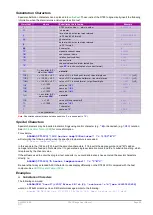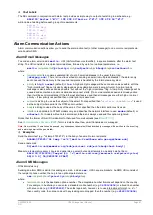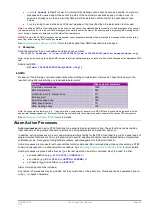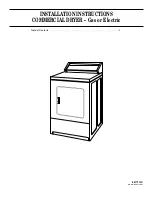
UM-0085-B09
DT80 Range User Manual
Page 98
RG
Retrieving Logged Data
Overview
There are several different ways to retrieve logged data from the DT80.
•
Use the
Retrieve Data
function in
dEX
. The graphical web-based interface allows you to select the desired time
range, among other options. Data will be downloaded to your computer and saved as a CSV or DBD format file.
•
Interactively send a data unload command (COPYD) to the logger's command interface, which will output
logged data in CSV, fixed or free format to the active communications port.
•
Insert a USB memory device and use
COPYD
to unload data to file(s) on the USB device in the desired format
(CSV/ DBD/ fixed/ free). To automate this process the command can be placed in an ONINSERT file on the
USB device, so that the unload is performed as soon as the USB device is inserted.
•
Include a
COPYD
command in your job to periodically unload data to a remote FTP server, or an email address,
or to a file on the internal file system or USB device.
•
Use
COPYD
(manually, or from the job – possibly in response to some event) to unload data to a local
archive
file
. An archive file is a DBD file which contains a read-only snapshot of the main store file, with any empty
space removed. Archive files can then be unloaded at a later date (using
COPYD
) into a CSV format file.
•
Use an FTP client to access the DT80's FTP server and collect any archive files or locally stored CSV files.
Unload Commands
The DT80 provides three related commands for unloading and managing logged data:
•
LISTD
gives details of the data available to unload, such as the number of logged records and the time range
that they cover.
•
COPYD
is used to extract selected data from store files and save it in the selected format to the selected
destination.
•
DELD
is used to remove data from a store file.
These three commands share a similar syntax: the command is followed by zero or more space-separated options. Each
option has the form name=value. The value may optionally be enclosed in quotes, i.e. name="option value". A typical
command line might be:
COPYD start=new dest=a:
Option names and values are not case-sensitive, and the options may be specified in any order. Option names (not
values) may also be abbreviated, so long as the result is not ambiguous. Thus the following is equivalent to the previous
command line:
copyd DEST=A: ST=NEW
All options have a default value, which will be used if the option is not specified.
LISTD – List Available Data
Using LISTD
In its simplest form, the
LISTD
command will list details for all store files associated with the current job. For example:
LISTD
Job Sch Type Ov Lg Go Recs Capacity
======== === ========== == == == ======== ========
*SAMPLE A Data Live Y Y N 46 34952
*SAMPLE A Data Arc 38 38
*SAMPLE B Data Live Y Y N 23 52428 —
*SAMPLE B Alarm Live Y Y N 3 1455
*SAMPLE B Data Arc 19 19
*SAMPLE B Alarm Arc 2 2
First Last File
=================== =================== ===========================================
2010-03-01 09:54:23 2010-03-11 19:32:00 B:\JOBS\SAMPLE\A\DATA_A.DBD
2010-03-01 09:54:23 2010-03-04 18:50:55 B:\JOBS\SAMPLE\002_20100311T193043.DBD
2010-03-01 09:54:24 2010-03-11 19:32:00 B:\JOBS\SAMPLE\B\DATA_B.DBD
2010-03-01 09:54:40 2010-03-11 19:32:00 B:\JOBS\SAMPLE\B\DATA_B.DBD
2010-03-01 09:54:24 2010-03-04 18:50:55 B:\JOBS\SAMPLE\002_20100311T193043.DBD
2010-03-01 09:54:40 2010-03-01 09:54:48 B:\JOBS\SAMPLE\002_20100311T193043.DBD
(The above listing has been split in order to fit with this manual's page width).
















































